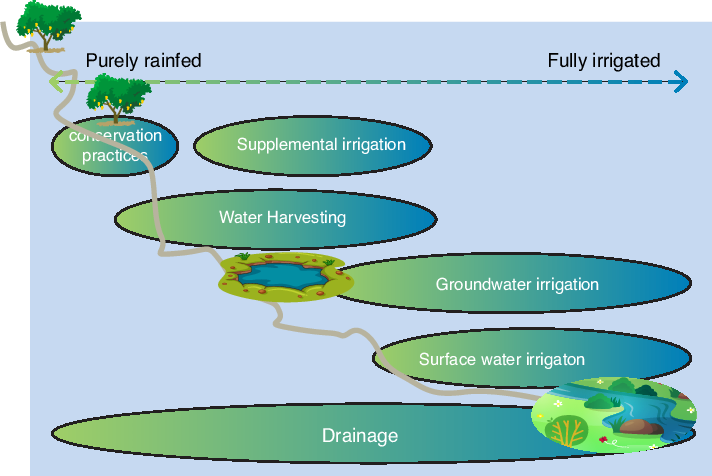Rainfed irrigation continuum
Water scarcity is a severe problem in developing countries. Most developing countries depend on rainfed agriculture. Despite its prevalence in developing countries, rainfed agriculture is less resilient to drought due to scarcity and variability of rainfall. Poor management of water in rainfed systems causes soil erosion, run-off, and low yields. The policies on the water resource management centered on irrigation while integrated water resources management at watershed and basin-scale focused on the blue water on rivers, lakes.
Agriculture relies on both green and blue water. Effective water management requires policies focused on green and blue water, particularly in the regions vulnerable to water scarcity. The shift of policy focusing on water management investment across the continuum from purely rainfed systems upstream to fully irrigation system downstream improves agricultural productivity, livelihood, and conserving the environment. The investment across the landscape includes soil and water conservation measures, water harvesting structures, and supplemental irrigation.
The improved water management of rainfed agriculture starts with soil and water conservation practices in the upstream area.
Water harvesting is the umbrella term for a variety of technologies aimed at concentrating and storing water. It can be either in situ by utilizing the soil to store infiltrated rainfall) or ex-situ in natural or man-made storage structures like dams and ponds.
Supplemental irrigation applies if the water supply is sufficient to meet the full demand for crop water. Supplemental irrigation collects the run-off from watershed areas outside of cultivated land and adds it to rainfed cropland. Supplemental irrigation is crucial because it can reduce the risks in rainfed agriculture by acting as a bridge during dry spells. Improved watershed management promotes groundwater recharge, which may increase the potential for shallow Well exploitation.
In a nutshell, upstream sustainable water management improves ground water recharge, increasing the availability of blue water downstream to apply for irrigation by ensuring a rain-fed irrigation continuum across the landscape.

References
Erkossa, T., et al. (2009). “Impacts of improving water management of smallholder agriculture in the Upper Blue Nile Basin.” Improved Water and Land Management in the Ethiopian Highlands: Its Impact on Downstream Stakeholders Dependent on the Blue Nile: 7.
Molden, D. (ed) (2007) Water for Food, Water for Life: A Comprehensive Assessment of Water Management in Agriculture. London: Earthscan, and Colombo: International Water Management Institute.
Wani, S. P., et al. (2009). “Rainfed agriculture–past trends and future prospects.” Rainfed agriculture: Unlocking the potential 7: 1-33.